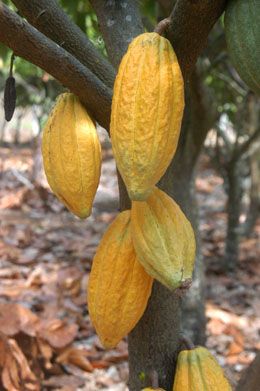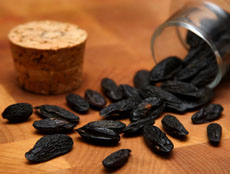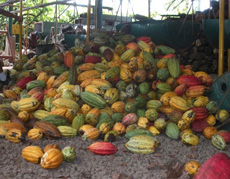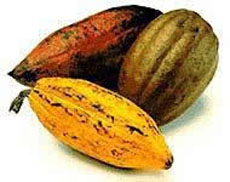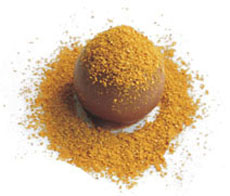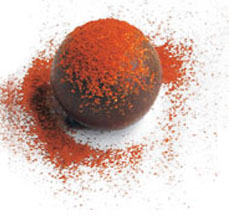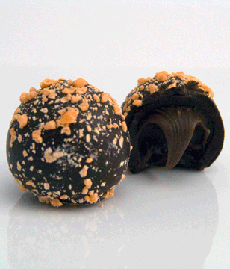
The original French truffle was a ball of ganache, rolled in a cocoa coating; later chopped nuts and confectioners’ sugar were added as coatings. Later, chocolatiers enrobed the ganache ball in a chocolate shell, like the truffles above. Photo courtesy TheCholive.com.
Last Updated May 2018 |
Product Reviews / Main Nibbles / ChocolateChocolate GlossaryChocolate Terms & Definitions: T
Here you’ll find terms including terroir, Theobroma cacao, Trinitario and truffle. If you think we should consider chocolate terms and definitions other than those we have provided, click on the Contact Us link on this page. Also enjoy our 60+ other food glossaries. Use this index bar to visit other pages. a b c d e f g h i j k l m n o p q r s t u v w x y z This glossary is protected by copyright and cannot be reproduced in whole or part.
TABLETTE or CHOCOLAT EN TABLETTEThe French word for a chocolate bar for eating. See also bâton. TEMPERINGChocolate is not shiny on its own: It needs to go through a process called tempering to achieve its glossy appearance and a pleasant mouthfeel. This involves an alternating process of heating, cooling, and heating again to specific temperatures to stabilize the mixture to obtain the smooth, shiny texture and a good snap when broken. Well-tempered chocolate melts better in the mouth and ages better. The word “temper” refers to the way chocolate solidifies. Only the cocoa butter particles become melted: Sugar and cocoa powder remain solids suspended in the fluid cocoa butter. When the melted chocolate cools and becomes solid again, the cocoa butter particles form a crystalline structure. The evenness of distribution of cocoa butter, and the type of crystals they form, comprise the temper. Chocolate is in good temper if the cocoa butter is mixed thoroughly and evenly throughout and the particles have cooled uniformly and completely. If not tempered properly the finished chocolate will be dull and streaky with a tendency to bloom. The classic tempering method is to melt the chocolate until it is lump-free. Then 1/3 of the chocolate is poured onto a marble slab, spread and worked back and forth with a metal spatula until it becomes thick and reaches a temperature of about 80°F. This chocolate is then added back to the remaining 2/3 of the melted chocolate and stirred. The process is repeated until the entire mixture reaches 88° to 92°F for semi-sweet chocolate, 84° to 87°F for milk or white chocolate. Care must be taken not to over-temper chocolate, which returns it to its original state—grainy and susceptible to bloom. TERROIRTerroir, pronounced tur-WAH, is the French word for soil, land or terrain. It can be loosely translated as “a sense of place,” the sum of the effects that the environment has on the creation of what is grown there. It has long been used in wine and coffee analysis to denote the special characteristics of soil, geology, aspect and altitude that give the grape or bean its individuality. The term is now being used, appropriately, to describe cacao beans.
THEOBROMINEA stimulant, one of the more than 400 compounds that comprise chocolate. The other major stimulant in chocolate is caffeine. THICKThick, also called pasty, refers to the texture of the chocolate. In order to achieve optimum smoothness and avoid being thick, some brands add extra cocoa butter. Thickness can be due to different factors: (1) The the lower fat content of the beans. Generally, higher grade beans do not require a great amount of added cocoa butter due to their already higher level of fat. (2) Some purist brands don’t use lecithin for added fluidity because it can mask some subtle aromas and flavors. As a result, the chocolate will not melt as smoothly in the mouth and will seem “thicker” in texture. (3) Chocolate of high cacao content, 80% and above, will have a thicker texture due to the higher amount of cocoa liquor. This feature is virtually unavoidable unless extra cocoa butter is added. However, an insignificant amount of coumarin would be ingested from food, and experts say it is not considered a health risk. It is used in perfume, and prior to being banned by the FDA in 1985, it was used to make vanilla extract and to flavor cigarettes. TORRONEPronounced toe-ROW-nay, the Italian word for nougat.
Trinitario cacao accounts for about 10% to 15% of current world production. Bars such as El Rey’s Carenero Superior, Domori’s Rio Caribe and Pralus bars from Colombia, Ecuador, Jamaica and Venezuela are made exclusively from Trinitario beans. See Theobroma cacao for more information. Since Trinitario beans can take their flavor characteristics from either their Criollo or Forastero descendants, experts recommend that you look at the origin of the bean—the single origin characteristics—to understand the flavor of cacao, rather than look at the Trinitario bean as having a specific flavor profile. This is true with Criollo and Forastero beans as well, both because of prolific crossbreeding of the cacao trees, and because there are few “pure species” cacao farms: In many farms, trees from two different species will grow side by side due to nature. Today’s truffles can be coated in nouvelle spices like peppercorns, sweet curry and paprika and can be enrobed in couverture. In 1912, the Belgian chocolatier Jean Neuhaus invented the first hard chocolate shell, enabling chocolates with soft fillings. While he called them pralines (see the dual meaning), other chocolatiers referred to them as truffles because early filled chocolates were filled with ganache. As words evolve, the term truffle is often used to in America to describe any filled chocolate, and it becomes very confusing: chocolate cremes or assorted chocolates, e.g., would be more accurate. If the term is applied to a filled, hard-shell chocolate, the use should be limited to round shells filled with ganache, like the truffles from Vosges Chocolate shown above. See the history of chocolate truffles.
Continue To Next Page: Terms With U To Z
Lifestyle Direct, Inc. All rights reserved. Images are the copyright of their respective owners.
|
Last Updated May 2018
© Copyright 2005-2025 Lifestyle Direct, Inc. All rights reserved. All images are copyrighted to their respective owners.
